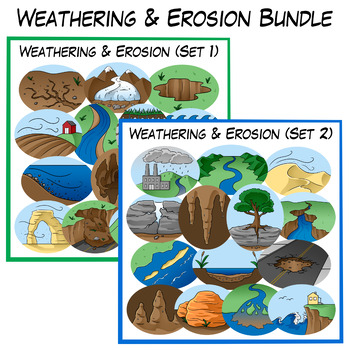Weathering and Erosion Clip Art Bundle
- Zip
What educators are saying
Products in this Bundle (2)
Also included in
- This earth science clip art bundle includes 587 high-quality, transparent, PNG images that come in color, grayscale, and lineart. For more details about the items in this bundle please see their individual product descriptions:Water CycleWeatherNatural Disasters & Extreme WeatherWeathering and EPrice $24.00Original Price $36.00Save $12.00
Description
This weathering and erosion bundle includes 114 high-quality, transparent, PNG images (28 unique designs). The following items come in full color, grayscale, and white-filled lineart (with and w/o border):
Set 1:
- glacial moraine
- glacier
- landslide
- deposition
- cave
- river meander
- windblown rock arch
- windblown field
- valley
- ocean sediment
- sinkhole
- sea stack
- rainwash
Set 2:
- acid rain
- stalagmites
- stalactites
- beach cliff erosion
- pond sediment
- ice wedging
- root wedging
- river delta
- ravine/canyon
- flood plain
- road pothole
- windblown sanddune
- barrier islands
Terms of Use: All images are available for personal and commercial use, including as movable pieces in digital resources such as those created for Google Classroom, PowerPoint, Boom Cards, etc (no additional license required). Clip art should be secured and flattened in PDF format or similar whenever possible. Do not resell or redistribute my artwork as is; it must be used as part of your own original product. Credit is appreciated in the form of a link to www.digitalclassroomclipart.com.
Keywords: changing landforms clipart, cut bank, point bar deposit, mudslide, sheet erosion, glacier erosion, mechanical weathering, chemical weathering, particle creep, saltation, sediment suspension, water erosion, surface runoff, storm surge, coastal erosion, canyon, sheet erosion, biological weathering, plant weathering, earth science clipart



